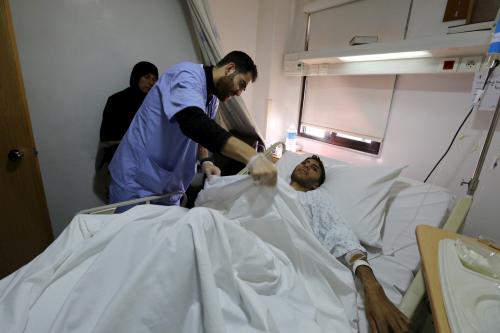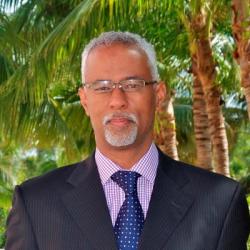Seven years of ongoing conflict have left the Libyan health system near collapse. Nearly 80 percent of foreign health workers who formed the core of the pre-2011 system have left. Recruitment of new workers is difficult, and remaining providers function under extremely difficult conditions. The militarization of health facilities and humanitarian aid has affected access and working conditions—staff have been threatened at gunpoint, beaten, and kidnapped. The looting, shelling, and destruction of medical facilities have led to chronic drug and equipment shortages, staff shortages, and increases in the price of medicines.
Libyan health professionals face challenges their predecessors never did. Diseases that had not been seen in the previous decade are returning: Malaria has recurred, polio is at risk of re-emerging, and strains of drug-resistant tuberculosis found in migrants to Europe are suspected of originating in Libya detention centers; in 2015 World Health Organization (WHO) estimated that 3.7 percent of all new tuberculosis cases are drug resistant. There is a greater need now for mental health services, but services are limited. In addition, the conflict has led to the internal displacement of Libyans fleeing violence. There are also about 670,000 migrants from West Africa, Asia, and the Middle East in Libya who have been lured by the possibility of migration to Europe by sea from Libya—raising daunting challenges to people getting the care they need.
What’s happening at primary health care facilities?
In collaboration with Libya’s Ministry of Health and the WHO, the World Bank conducted a rapid survey in March 2018 at primary health care (PHC) facilities with 1,012 patients (510 in Benghazi and 502 in Tripoli) and 510 service providers (273 and 237 in Benghazi and Tripoli, respectively). 98 percent of them were Libyan trained. The data showed the following:
Proximity to a clinic does not guarantee utilization. Approximately a third of all patients do not go to the clinic closest to their home. Lack of doctors and nurses, medications, and overcrowding were the primary reasons that patients used more distant PHC facilities.
There are significant gaps in the quality of care being provided. Many of the patients did not recall receiving physical exams or having vital signs checked when visiting PHC facilities. Only 21 percent reported that their temperature had been taken; 13 percent reported that their pulse was taken, and 27 percent reported that their blood pressure was measured (see Figure 1).
Figure 1. Gaps in quality of care

Salaries are not being paid in full, or on time. In the 3 months prior to the survey, December 2017-March 2018, 88 percent of providers reported that they had not been paid on time, and 52 percent reported that they had not been paid in full. Delayed payments were a problem in both surveyed cities (Benghazi and Tripoli). However, more providers in Tripoli (57 percent) reported not receiving their full salary compared to their colleagues in Benghazi (48 percent).
Health providers are taking second jobs. In Benghazi, 74 percent of the providers interviewed said they had a second job, compared to 32 percent in Tripoli. Overall, across the two cities, 40 percent of the providers interviewed also worked in a private facility, and 14 percent worked in another public clinic.
Few providers have received in-service training. In both Tripoli and Benghazi, approximately 75 percent of health care providers had not received any training in the last 3 years. The majority (85 percent) reported that they needed additional training to address the new challenges they were facing. The influx of migrants, internally displaced persons (IDPs), and refugees and the need for new services (e.g., extensive mental health and psychosocial support) are placing additional demands on staff.
Providers are delivering care without the needed infrastructure or medicines. Providers in both cities face significant challenges given the lack of regular heating, water supplies, electricity and safety issues in the area surrounding health facilities (Figure 2). In both cities approximately a third of providers reported that security issues near their facilities affected their ability to deliver care. Stockouts are common: 57 percent of providers reported that the lack of basic supplies—for example, bandages, and syringes; functional medical equipment; and administrative materials/supplies—adversely affected their ability to perform their jobs.
Figure 2. Providers reporting problem over the past three months

What do we do next?
Libya does not attract significant donor support for health. In 2017, the health sector received just $16.7 million (11.2 percent) of the $152.7 million provided to support the overall humanitarian response in Libya. The four main donors were the EU (29.4 percent), Germany (23.5 percent), Italy (15.3 percent), and the U.S. (9.9 percent). The health budget in the 2018 Libya Humanitarian Response Plan is $46.2 million; however, the full amount may not be secured given that only 69 percent of the 2017 Response Plan was funded. At the same time, over the last 5 years, Libya has invested nearly 3 billion Libyan dinar (LYD) (2.1 billion in USD) annually in the health sector. But conflict and systemic inefficiencies have reduced the ability of the health sector to deliver services (see Figure 3).
Figure 3. Libya health expenditures (LYD) 2012-2017

Revisit the middle-income country-in-crisis dilemma. Libya has tremendous carbon fuel resources, a small population, and a relatively high per capita GDP (estimated at close to $8,000 in 2017). Libya had foreign exchange reserves of about $72.6 billion at the end of 2017. Its health system is near collapse. But its income status makes it ineligible to receive grant or concessional funds from the International Development Association (IDA), Gavi, or the Global Fund. The national, regional, and global public health risks of a deteriorating health system, in a country faced with a growing influx of refugees, and a large number of internally displaced persons, must be taken into account.
Examine how providers are operating in the private sector. Conflict creates business opportunities. The market for insulin, an essential diabetes medication, is an example of the Libyan private sector compensating for drug shortages in the public sector. Yet, the dynamics of the private health sector are not fully known, nor is how the Libyan population shops for and sells services between the public and private sectors, or how such market forces affect the financial well-being of already vulnerable populations.
Identify how IDPs, refugees, and migrants are accessing health services. According to the latest International Organization for Migration (IOM) data, there are nearly 669,176 migrants, 193,521 internally displaced persons (IDPs), and 382,222 returnees. Survey data from 2016 showed that 60 percent of migrants intended to stay in Libya to work, with the remainder (40 percent) seeking to migrate. Not all migrants face the same challenges: for example, there are long established patterns of circular migration with Niger and Egypt, and Arab speakers are better able to navigate the society. There are reports of racial and gender discrimination against migrants from sub-Saharan Africa that may limit their access to services. However, most facility data are not disaggregated to identify access and service utilization by IDPs, migrants, and refugees. Resources need to be dedicated to documenting the needs of all populations and supporting policies that improve equity in access to care.
The Brookings Institution is committed to quality, independence, and impact.
We are supported by a diverse array of funders. In line with our values and policies, each Brookings publication represents the sole views of its author(s).









Commentary
Is there a doctor in the house? The challenge of primary health care in Libya
December 10, 2018